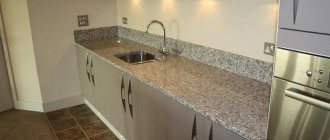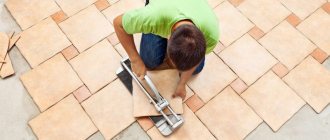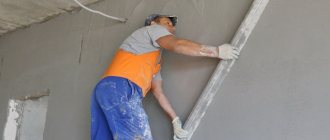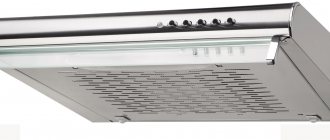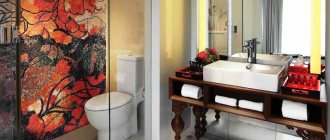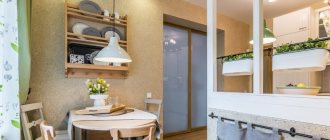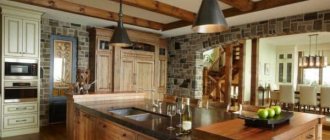The kitchen is a room in the house that is very often visited by everyone in the household. It should be cozy, but also functional and practical. When renovating a kitchen, special attention should be paid to the finishing of the walls. It is necessary to ensure that the coating is as suitable as possible for the conditions in which it is used.
Decorative plaster is perfect for the kitchen and will become its decoration. In this article we will talk about the use of this coating in the kitchen and its types.
What is decorative plaster
Decorative plaster has long been successfully used to decorate all areas of the house, including the kitchen and even the bathroom. Modern decorative plaster has little in common with the usual gray mass. From her this material only inherited its name. Now decorative plaster is divided into types, and the finished coating can look completely different.
It is divided according to its composition into synthetic and mineral. The first type uses polymer materials such as acrylic or styrene as a binder, and the second uses cement, lime, and gypsum.
Advice! Acrylic decorative plaster is best suited for the kitchen.
In addition to the binder, the material contains a filler, which is quartz, marble or granite in the form of chips. Different combinations of filler and binder give a completely different appearance to the finished coating.
Particular attention should be paid to the properties of this material, which allow it to be used in finishing the kitchen area:
- Durability and strength. The material does not lose its properties over time, even when used in the kitchen.
- High strength. Since the mass basically contains stone chips, it is very durable.
- Resistance to humidity and temperature changes, as well as aggressive external influences.
- Variety of possible coatings.
Which decorative plaster to choose for the kitchen?
And so we will analyze the types of applied fabric according to the composition of the material filling. There are 4 main types. The basis of the chemical composition and binder determines the technical characteristics, scope of application and method of application.
Varieties by composition
Mineral. Made on the basis of gypsum, cement, lime, clay with the addition of decorative elements, such as sand, granite, marble powder and many other fillers, synthetic or natural. It is used for both internal and external wall cladding. Solutions can be in different compositions, individual components or combined, with a predominance of one or another component.
- A mixture containing gypsum. Some subspecies are not recommended when using facade finishing and in rooms with high humidity, such as kitchens and bathrooms.
- The bulk of the solutions are formed on a gypsum basis and it is the most common. To increase its technical properties, various additives are added in the form of antiseptics and hydrophobic fillers. Due to this, it is widely used in rooms with a high moisture threshold.
- The cement-based material is quite resistant to moisture, and is often used in kitchens, but it is not entirely a decorative material. Typically, cement acts as an additional filler, affecting its character.
Silicate. The main composition contains liquid glass. In addition to facade decoration, it is also used for interior wall cladding. The most durable and strong material of all presented. Has a high price.
Acrylic or polymer. This variety is often found in the decoration of kitchen rooms. Produced on the basis of epoxy and acrylic resins, polyurethane. This plaster is durable, flexible, and copes well with aggressive climates.
Silicone. Applicable in all rooms, kitchens, baths, and also suitable for external walls. The base contains synthetic resin. Quite flexible and durable material. Sold ready-made, easy to use, but has a high price.
Many construction experts do not recommend using gypsum-based decorating mixture in wet rooms, and opinions on this issue are divided. In practice, there are cases when the kitchen is finished with decorative plaster based on gypsum, and there are positive responses.
- According to the main characteristics, any decorative plaster is suitable for framing walls in the kitchen; each composition makes the material sufficiently durable and moisture-resistant. The most common are acrylic, gypsum and lime masses.
- For example, to cover areas of the apron or dining area, it is better to choose smooth textures; in areas of low abrasion of the surface, it is permissible to lay any desired patterns. This is due to the possibility of easy maintenance, and if the surface is smooth, then it absorbs dirt much less and is much easier to clean.
Today, many people use simple gypsum plasters, for example, by mixing the finishing and starting mixtures, then diluting them with color, creating solutions that can decoratively decorate walls. To increase moisture resistance, when diluting the dry mixture, acrylic primers are added in place of the water. In this way, the technical characteristics of the material are significantly increased, making it possible to finish the walls in the kitchen. After the work is done, it is covered with varnish, wax or the same primer. The result is a decorative surface for a small investment.
The construction market offers mixtures designed specifically for kitchens.
Also read: Interior finishing with imitation timber; DIY wall mounting
Types of texture
It is divided into two main types, these are structural and textured solutions. Further, the names are determined by the external effect and relief of the canvas.
- Structural plaster. (bark beetle, fur coat, lamb and other structural formations)
- Textured mixture. (imitation velvet, leather, wood, silk, porcelain stoneware, world map, Venetian, travertine, sea breeze, concrete, gold, metal and other texture options)
- Flock. (silk and cellulose are added as a decorative element) Know-how from the manufacturers; after application, fibers are sprayed, creating an interesting silk surface.
- Venetian surface. (more often it looks like marble, contains marble dust) other imitations of stone are also possible.
- Smooth texture. (flat surface, usually colored masses with different outlines)
- Sgraffito. (drawings, inscriptions, etc.) Using stencils or by hand, a convex relief is created; here the name implies the creation of a relief ornament.
Choose the appearance of the future surface according to your preferences. With a variety of color palettes and a wide range of different looks, decorative plaster walls in the kitchen will create a beautiful look with a unique design. In addition, it is possible to set an individual look using various tools to create relief.
Manufacturers offer a large selection of textures, each time adding new options both in composition and in appearance. This article presents only a few types.
Varieties, video
Characteristics
Decorative plaster is a universal material suitable for all types of premises; it is also widely used for external decoration. Like any type of finish, any coating has its advantages and disadvantages.
Minuses
- High cost, the material itself is more expensive than ordinary plaster. And it is advisable to carry out the work by the hands of a professional, especially when creating relief images. Applying highly paid labor.
- When the building shrinks, cracks may appear in some varieties; in new houses it is better to refuse and wait a while.
- Installation involves a labor-intensive, time-consuming and dusty process. After application it takes a long time to dry, from 2 to 7 days.
- Difficult dismantling. The coating is difficult to remove, as it is very firmly connected to the wall, which creates difficulties when repairing and replacing the coating.
Also read: Aprons for the kitchen; material and design options
pros
- Thanks to antiseptic additives it is protected from fungus and mold.
- Positive performance characteristics include resistance to external physical damage, does not accumulate dust, are not affected by moisture, and does not absorb odors. Easy to clean and wipe clean.
- Lays on any surface, concrete, brick, wood, metal, adheres well and does not peel off.
- A smooth, seamless monolithic surface is created. It has excellent aesthetic qualities and makes it possible to create various attractive images of any complexity. Noble appearance and unique design.
- Decorative plaster instead of tiles in the kitchen, as a new and alternative way of decorating walls, which is increasingly gaining popularity. This surface is in no way inferior to ceramic tiles, and in some versions it looks much more interesting.
Advantages and disadvantages of decorative plaster in the kitchen
This type of coating is perfect for decorating a kitchen due to its advantages:
- No seams. Due to the fact that the finished coating does not have seams, it not only looks aesthetically better, but also does not cause a situation where the canvases dry out, forming cracks into which dirt and grease can get clogged.
- Waterproofing and soundproofing qualities, as well as good heat retention and the ability to wet clean.
- Environmentally friendly and safe for the environment and humans. Decorative plaster is fire resistant and antiseptic.
Decorative plaster, due to all the above circumstances, can be used as a coating for the kitchen. But it also has minor disadvantages:
- Difficulty in dismantling the coating. Unlike wallpaper, it is not so easy to tear it off the walls. You can remove it using a grinder with special attachments, making considerable effort.
- Difficulty in applying it yourself. Before making repairs using such material, you need to study the technology of its application. Otherwise, you can ruin the appearance of the walls and the material itself.
- High price. This indicator is not so significant, since the decorative coating will last for many years and you will not have to spend money on regular repairs.
Types of plaster mortar
If desired, you can make wall cladding with one of the types of decorative plaster. After applying the solution to the walls, no additional finishing of the walls is required. Each type of plaster gives the wall a certain texture.
Textured plaster.
A liquid plaster solution is applied to the wall with a roller. When carefully rolling out the plaster, the surface of the wall has a relief texture in the form of small droplets. The colored tint can be immediately added to this solution.
Structural plaster.
This plaster contains marble chips. When applying plaster mortar to the wall, large particles of crumbs create textured grooves. As a final result, the plastered surface takes the shape of tree bark. This plaster can be painted any color.
Venetian plaster.
This is expensive plaster. When worked correctly with this plaster, the end result justifies the expensive costs. Venetian plaster consists of marble colored powder and a latex binder.
Types of decorative plaster
There are a huge number of types of decorative plaster and all of them are suitable for decorating a kitchen. The only thing is that you need to get acquainted with what each one looks like and choose the one that suits the style of the interior. Below are descriptions and photos.
There are several main types of decorative plaster:
Venetian is a material that produces a surface that resembles marble. It will fit perfectly into a kitchen interior in a classic, art deco, modern or minimalist style. But there is no need to finish the kitchen apron with such a coating, since it must be constantly cleaned, and regular cleaning can lead to loss of shine of the coating.
In addition to the marble effect, this look can also be produced by others similar to stones such as quartz, jasper, malachite, onyx and others. The texture of Venetian plaster may not be perfectly smooth, but may have a relief. The main differences from other types are the color shifts, glow effect, and stone veins.
Silk is a less successful option for the kitchen, since the surface of this coating is porous, as a result of which dirt and grease will clog these very pores. But its use is not prohibited and it is quite possible to decorate the kitchen with such material, only after application it is protected with a wax layer, which will give a certain dirt- and water-repellent effect.
Textured - a structured look that results in a relief coating. The design is applied with special rollers and a variety of homemade tools. For example, the texture of bamboo can be achieved by wrapping a thick structural rope around a regular roller and walking over the wet plaster. The easiest way to create a relief is to walk over a damp surface with a fur roller and then paint the walls. Thus, an interesting relief is obtained.
“Bark beetle” plaster is a coating in which granite or marble chips are used as a filler. After application, it is leveled, and the marble or granite chips that are present in the composition leave marks on the wall similar to the passages of a bark beetle. The depth and size of the grooves can vary and depend on how large the particles are in the composition. This design looks very beautiful, in addition, it can be covered in any color.
This material can be used in styles such as country, Provence, loft, and Mediterranean style.
Plaster “Crackelure” - this coating in the kitchen will become its calling card, since when it dries it gives the original cracking effect shown in the photo. Craquelure goes well with Venetian, which can be applied in a thin layer over the main coating.
Interesting! A type of plaster has been invented that contains granules that burst when applied and form a certain relief.
Sgraffito is an application technique that involves creating a base layer and then scratching a design onto it using a stencil, which is covered with a layer of a different color. As a result, the wall looks very impressive. In the kitchen, you can decorate the dining area this way. This will give extraordinary comfort and modern notes.
What you should know about decorative plaster before purchasing
Decorative plaster is a paste of uniform consistency made from a binder, dye, water and filler. Litter varies in type, size and shape. These can be fabric fibers, acrylic resins, synthetic granules, chips of natural stone of various types: granite, quartz, marble. The appearance of the finish depends on the composition of the plaster and the size of the filler particles. The larger the particles, the more textured the pattern will be.
Having previously thought through the idea of the kitchen interior, choose a coating and a method of applying it. The most common methods:
- Sgraffito is the use of stencils to create drawings.
- Flocking is the application of textile fibers to obtain a new structure. It is better to use in the dining area, as fabric fibers absorb odors, fat and moisture.
- A roller with a textured pattern, which is used to roll over the plaster that has not yet dried.
- Drawing with a wire brush on a freshly applied coating. After a day, the surface is cleaned with a sponge.
- Spraying - applying texture using a spatula, trowel and other available tools. Plastering tools used: coarse brush, wide and narrow spatula, roller, brush.
Types of decorative plaster for the kitchen
To understand which decorative plaster to choose for the kitchen, let’s study the composition of various types of coating:
- Natural marble or granite chips and quartz sand are added to cement-based mineral plaster, thereby creating a relief surface. Gypsum-based coating is not suitable for the kitchen. Gypsum absorbs water, swells and loses its properties.
- Acrylic contains acrylic resins at its base. This is a good choice for the kitchen. It will create a durable and strong wall covering.
- Silicate plaster with a liquid glass base is recommended for use on walls made of wood or cellular concrete due to its vapor permeability.
- Silicone plaster is plastic and suitable for application by hand. Has good adhesion to many substrates.
In appearance, plaster can be:
- Structural - depending on the size of the fractions included in it, it is divided into coarse-grained and fine-grained; When applied, large grains in the plaster form deep grooves, resulting in a “bark beetle” pattern. Bark beetle plaster in the kitchen goes well with furniture in the Provence style.
- Venetian contains marble dust and creates a smooth surface reminiscent of marble. Venetian, as one of the most expensive and beautiful coatings, belongs to the category of elite finishing and is used to create palace interiors in the baroque and classicism styles.
- Textured imitates various materials: wood, leather, concrete, crinkled fabric, etc.
- The smooth coating is suitable for different interiors. Bright kitchen furniture and textiles will balance the smooth walls in a calm color scheme. A minimalist interior with high-tech furniture will be complemented by richly colored walls.
Advantages and disadvantages of the material
Advantages of using decorative coating:
- plaster for walls in the kitchen does not emit toxic substances, therefore it is safe for health;
- the breathability of the coating allows you to regulate the microclimate in the room;
- fire safety due to the fire resistance of the coating;
- masks minor wall defects, seamless, applied in an even layer to any surface;
- resistance to abrasion, damage, mold;
- ability to withstand wet cleaning, ease of maintenance, which is very important for the kitchen;
- With the help of decorative plaster it is easy to create an interesting and unique design.
The disadvantage of this material is its high cost. It is better to entrust the work of applying it to specialists, which is also quite expensive.
Characteristics of using decorative plaster in the kitchen
Decorative plaster in the kitchen is used as the imagination desires, but complete wall decoration with this material looks ordinary. It loses its unique decorative qualities and this design becomes boring. In order for plaster in the interior to look interesting and fashionable, you need to take into account the following recommendations:
- You should not cover more than one wall in the kitchen with this material. This finishing material is perfect for zoning the kitchen area and dining room, but in combination with other materials.
- You need to choose the right shade. The material will look appropriate and stylish in the kitchen interior if it becomes an accent or is close in shade to the furniture, floor color or accessories. Matching the color of the walls and the kitchen unit also looks advantageous.
- The ceiling can be decorated with decorative plaster. Yes, and this is not a myth. It’s possible to make such a design and the room will immediately sparkle with new colors. The only thing is that you need to use only light colors that do not weigh down the space.
Pros and cons of decorative plaster
Decorative plaster in the kitchen interior has undeniable advantages:
Venetian plaster is a decorative material that imitates marble
- easy to clean without damaging the top finishing layer;
- retains its original color and texture for decades;
- vapor permeable, homogeneous (no seams);
- has excellent sound insulation;
- safe and environmentally friendly (does not emit toxic substances, does not burn, has antiseptic properties);
- does not absorb kitchen odors and moisture;
- resistant to the negative effects of high temperatures;
- quickly applied to the surface;
- hides minor defects and uneven walls;
- successfully combined with wallpaper, ceramic tiles, wood panels;
- provides an opportunity for creativity;
- has a wide palette of shades and textures.
In the kitchen, you should not decorate the walls with an overly rough coating. A rough surface becomes dirty more quickly and is susceptible to mold growth with high humidity. But such a decorative coating of the walls helps to hide flaws (therefore, at the preparatory stage you don’t have to achieve perfect evenness).
For the kitchen, the best option would be a smooth, glossy finish with a protective layer of varnish or wax applied. As an option, the walls are decorated with a textured coating, but the apron around the perimeter of the work area is finished with ceramic tiles or tempered glass.
Elegant distribution of details
Finishing kitchen walls with decorative plaster still has minor drawbacks:
- high cost of material (but it pays off in the first years);
- problematic dismantling (to remove such a coating, at a minimum, you will need a grinder and a hammer drill. The work is hard and dusty);
- complexity of the work (without basic skills it is difficult to apply a complex coating, it is better to invite a specialist).
Design Tips
Finishing a kitchen with decorative plaster has its own nuances, which not everyone knows about. Famous designers do not recommend decorating all the walls of the kitchen with such a coating. The fact is that over time such a motley finish will get boring. It is better to use this material to place accents in the room and play on contrast:
- One wall is decorated with a textured coating, thus solving the problem of zoning the kitchen.
- The color of the composition is selected so that it harmonizes and matches the kitchen set or floor covering. Well-chosen color contrasts look no less impressive than a harmonious tone-on-tone combination.
- Kitchen plaster is even used to cover the ceiling. A room decorated in this way becomes unique and unusual.
- Three-dimensional images and ornaments made on uncured composition using stencils look interesting.
- The hands of a professional craftsman with artistic taste can even create real paintings from decorative plaster.
Decorating a small room
